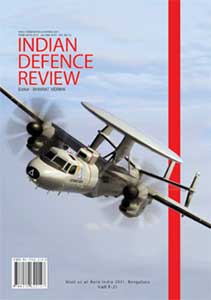Limited Force Option: A campaign employing limited force option could include computer network attacks against the Taiwan’s political, military and economic infrastructure to undermine Taiwan population’s confidence in its leadership. PLA’s special operation forces infiltrated into Taiwan could conduct acts of economic, political and military sabotage. Beijing might also believe that it could use small numbers of coordinated SRBMs and air strikes against air fields, radar and communications facilities on Taiwan as non-war use of force to try to push the Taiwan leadership towards accommodation. Beijing might erroneously view such non-war uses of forces as a complement to non-military coercion and believe that such strikes would not trigger a response from either Taiwan or third parties. Resort to such uses of force could quickly risk escalation to a full-fledged military conflict.
| Editor’s Pick |
Air and Missile Campaign: Surprise SRBM attacks and precision air attacks could support a campaign designed to degrade Taiwan defences, neutralize its military and political leadership and break its will to fight before the United States and other nations could intervene. China could employ SRBM to saturate Taiwan air defense system including air bases, radar sites, missiles and communications facilities.
Blockade: Beijing could threaten or deploy a naval blockade either as a non-war pressure tactic in the pre-hostility phase or as a transition to active conflict. On one end of the spectrum, Beijing could declare that ships en route to Taiwan ports must stop in mainland ports for inspection prior to transiting on to Taiwan.
 Alternatively China could attempt the equivalent of a blockade of Taiwan ports by declaring exercise or missile closure areas in approaches and roadsteads to ports to divert merchant traffic, which it did with its 1995-96 missile firings and live- fire exercise. Chinese doctrine also includes activities such as air blockades, missile attacks and mining or otherwise obstructing harbors and approaches.
Alternatively China could attempt the equivalent of a blockade of Taiwan ports by declaring exercise or missile closure areas in approaches and roadsteads to ports to divert merchant traffic, which it did with its 1995-96 missile firings and live- fire exercise. Chinese doctrine also includes activities such as air blockades, missile attacks and mining or otherwise obstructing harbors and approaches.
More traditional methods of blockade would increase the impact on Taiwan but also tax PLA Navy capabilities and raise the potential for direct military confrontation. Any attempt to limit maritime traffic to and from Taiwan, whether loose or more restrictive, would violate international law, trigger countervailing international pressure and could lead to a more protracted conflict with the serious risk of military escalation. Although such restrictions would have an immediate economic impact, they would take time to realize decisive political results, diminishing the ultimate effectiveness and inviting certain international reaction.
Amphibious Invasion: Publicly available Chinese writings on amphibious campaigns offer different strategies for an amphibious invasion of Taiwan. The most prominent of them describe what it called the Joint Island Landing Campaign. The objective of the Joint Island Landing Campaign is to break through or circumvent shore defences, establish and build a beachhead and then launch an attack to split, seize and occupy the entire island or important targets on the island.
Any attempt to limit maritime traffic to and from Taiwan, whether loose or more restrictive, would violate international law, trigger countervailing international pressure and could lead to a more protracted conflict with the serious risk of military escalation.
To achieve the final objective of the Joint Island Landing Campaign, a series of sub-campaigns, such as electronic warfare, naval and air campaigns including the underlying logistics and mobilization must be executed.
Amphibious operations are logistics-intensive and rely for success on air and sea superiority in the vicinity of the operation, and the rapid building up of supplies and sustainment on shore thereafter. The Joint Island Landing Campaign would tax the lift capacities of China’s armed forces and maritime militia, posing challenges to those charged with providing sustainment, and the commanders leading this campaign. Add to those strains the combat attrition of China’s forces. An amphibious invasion of Taiwan would be a significant political and military risk for China’s leaders. The PLA’s prospects in an invasion of Taiwan would hinge on establishing persistent air superiority over the Strait and Taiwan, the availability of amphibious and air lift capabilities, attrition rates, interoperability of PLA forces, the ability of China’s logistic system to support the necessarily high tempo of operations Taiwan’s will to resist and the speed and scale of international intervention.




